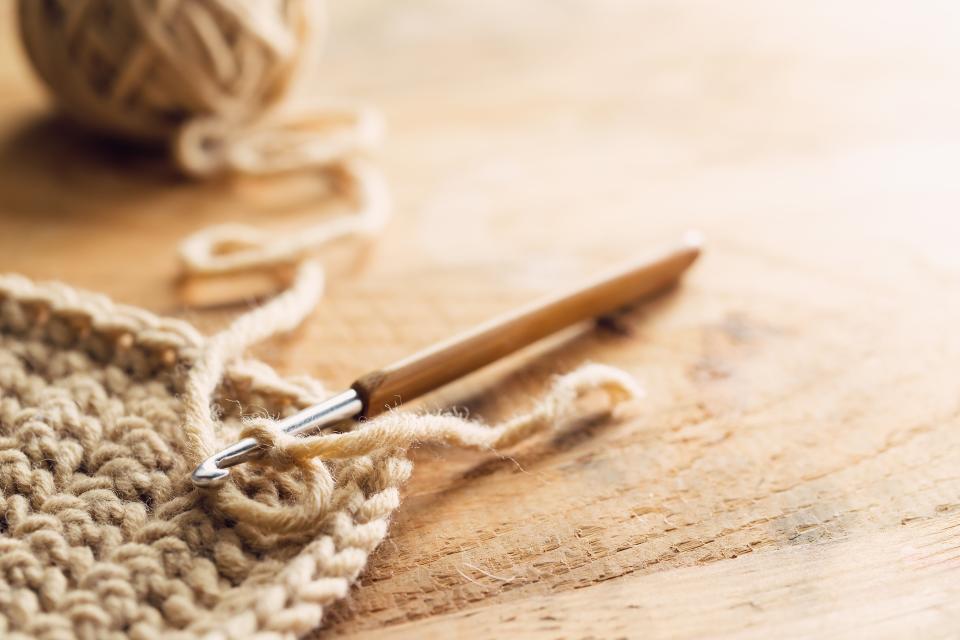A Guide to Crochet Hooks and How to Use Them

Once you've learned how to crochet, which hook should you choose for your first (or fiftieth) project? This helpful guide walks you through the differences in size, material, and style of crochet hooks, as well as how to hold them. Not all hooks are equal, but there's no need to feel overwhelmed by the options. Here's how to select the best one for you.

gojak / Getty
Related: Our Editors Share Their Favorite Sources for Quality Yarn
Materials
Crochet hooks come in a variety of different materials, including wood, plastic, metal, and even glass. Metal hooks are popular because they're usually inexpensive. The classic anodized aluminum hooks in many colors are strong and last a long time, which is why you may encounter bundles of these from days gone by—they still work. Wood hooks are beautiful and come in many shapes and styles so you can find what fits your hand the best. When selecting a wooden crochet hook, look for a strong material—like birch or rosewood—to avoid breakage; bamboo is also a good alternative. Very small wood hooks are more likely to break. Plastic hooks are also popular, especially when you need a very large crochet hook. You'll even find plastic hooks outfitted with a light so you can crochet in low light. In addition to all-plastic hooks, some companies make hooks with metal tips and plastic handles for a more ergonomic option.
Sizes
The size of a crochet hook is based on the thickness of the shaft or cylinder, which is what establishes the size of the stitches. In the United States, hook sizes are usually listed with a letter and a number, although some have only a letter or a number. Canada and the United Kingdom have used a different numbering system, but more and more hooks from all regions now include the actual size given in millimeters. (For instance, a 7mm crochet hook is recommended for making miniature crochet wreaths.) You should always check which terminology a pattern uses so you grab the right hook. Conversion charts help ensure that your hook is the correct size.
Finding the right size for a crochet hook is important because it determines the gauge of your crochet. Smaller hooks make finer and tighter crochet, while larger hooks produce a bulkier, more open weave. Patterns and yarn labels always suggest what size hook to use, but you may need to switch to a different size to achieve the correct gauge.
Types of Tips
Although all crochet hooks have a hook at the tip, the style of that hook varies. There are two main types of tip: inline and tapered. Inline hooks look like a cylinder with a notch cut out to form the hook. The hook itself is in line with the shaft or handle. Tapered hooks have a more rounded hook at the tip and the hook extends just past the shaft or handle. No matter which type you choose, always be sure to slide your crochet stitches all the way onto the shaft portion of the hook so they are the correct size. If the stitches stay too close to the tip, they may end up small or uneven. These two styles feel different when you crochet, but they both work the same so you can use what you like best. This process is easier for some with an inline hook because the thickness of the cylinder is more consistent.
Tunisian Hooks
Although most crochet hooks are around six inches long, you may see longer hooks including ones with a long cable attached. These are for Tunisian crochet, which is a hybrid of crochet and knitting. Like crochet, you hook the stitches, but like knitting, you keep the stitches on the hook. Tunisian crochet hooks come in different thicknesses and lengths, and you can choose hooks with or without cables.
How to Grip a Crochet Hook
Everyone holds their crochet hook a little differently, but what's most important is that you're comfortable as you work. Most people use one of two main grip styles as they work. The first method for holding your hook is the knife grip. For this, you hold the hook similar to when you use a knife for cutting food. Grip the hook with your thumb and three fingers, placing your index finger on the top of the hook to help stabilize and guide it. Another favorite way to hold a crochet hook is the pencil grip. With this method, you hold the hook just like you hold a pencil, gripping it with your thumb and index finger while stabilizing it with your hand and bent fingers.

